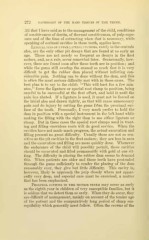Page 424 - My FlipBook
P. 424
272 PATHOLOGY OF THE HAED TISSUES OF THE TEETH.
All that I have said as to the management of the child, conditions
of sensitiveness of dentin, of thermal sensitiveness, of pulp expo-
sure and of the time of extracting when that is necessary, while
speaking of occlusal cavities in these teeth, applies here.
Lixgual pits of upper lateral ixcisors, rarely in the centrals
also, are the only other pit decays that are found at so early an
age. These are not nearly so frequent as decays in the first
molars, and, as a rule, occur somewhat later. Occasionally, how-
ever, these are found soon after these teeth are in position ; and
while the gums still overlap the enamel so much that it is very
difficult to get the rubber dam placed without inflicting con-
siderable pain. Nothing can be done without the dam, and this
is often the most serious difficulty met with in these cases. The
best plan is to say to the child: "This will hurt for a few min-
utes," force the ligature or special root clamp to position, being
careful to be successful at the first effort, and hold it until the
pain has abated. If a ligature is used, it must not be forced on
the labial also and drawn tightly, as that will cause unnecessary
pain and do injury by cutting the gums from the proximal sur-
face of the tooth. Personally, I very much prefer to hold the
dam in position with a special instrument in the left hand while
making the filling with the right than to use either ligature or
clamp. But in these cases the special root clamps used in treat-
ing and filling crownless roots will do good service. "When the
cavities have not made much progress, the actual excavation and
filling present no great difficulty. Usually these are not so sen-
sitive as the pit cavities in the first molars ; they are less in area
and the excavation and filling are more quickly done. "Whenever
the endurance of the child will possibly permit, these cavities
should be excavated and filled permanently with gold at one sit-
ting. The difficulty in placing the rubber dam seems to demand
this. When patients are older and these teeth have protruded
through the gums sufficiently to render the placing of the dam
reasonably easy, they give but little difficulty. This cavity is,
however, likely to approach the pulp closely where not appar-
ently very deep, and especial care must be exercised, a matter
that has been emphasized.
Proximal cavities in the incisor teeth may occur as early
as the eighth year in children of very susceptible families, but it
is seldom that we detect them so early. "When they do occur, they
are difficult of management, mainly on account of the tender age
of the patient and the comparatively long period of sharp sus-
ceptibility which generally must follow. Often the crowns of the


